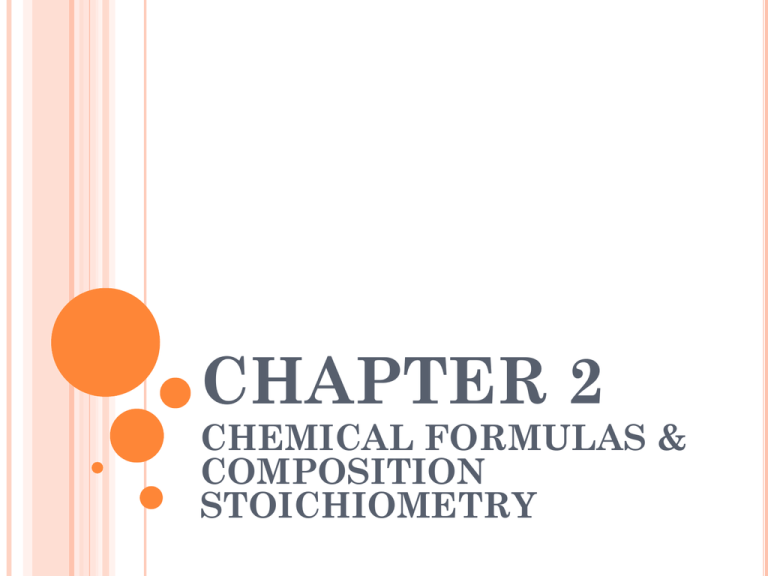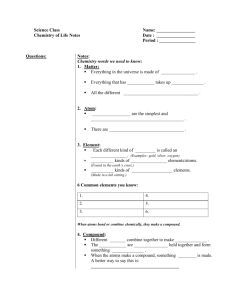Ch. 2 notes
advertisement

CHAPTER 2 CHEMICAL FORMULAS & COMPOSITION STOICHIOMETRY CHEMICAL FORMULAS show the ratio of the elements present in the molecule or compound He, Au, Na - monatomic O2, H2, Cl2 - diatomic O3, P4, S8 - more complex elements H2O, C12H22O11 – compounds ~ contains 2 or more elements Allotropes ~ different forms of the same element in the same physical state. Ex. Both O2 and O3 are gases Compound HCl H2O NH3 C4H10 1 Molecule Contains 1 H atom & 1 Cl atom ratio of elements: 1/1 2 H atoms & 1 O atom ratio of elements: 2/1 1 N atom & 3 H atoms ratio of elements: 1/3 4 C atoms & 10 H atoms ratio of elements: 4/10 = 2/5 IONS & IONIC COMPOUNDS ions are atoms or groups of atoms with an electrical charge two basic types of ions positive ions or cations (+) negative ions or anions (-) one or more electrons less than neutral, ex. Na+ one or more electrons more than neutral, ex. Cl- cations + anions must give neutral charge KOH CaSO4 Sr3N2 Al(OH)3 potassium hydroxide (+1 & -1) calcium sulfate (+2 & -2) strontium nitride ((2x3)&(-3x2)) aluminum hydroxide (+3 & (-1x3)) IONS & IONIC COMPOUNDS Sodium chloride - table salt is an ionic compound When a soluble ionic compound is dissolved in water, it dissociates (breaks apart) into its ions. Ex. Salt in water, Na+ and Cl ATOMIC WEIGHTS Scientists made a scale for comparing the masses of all elements. The units are arbitrary ~ called atomic mass units (amu) How? Weighted average of the masses of the constituent isotopes, its the lower number on periodic chart 1 amu = 1/12 mass of Carbon-12 On the periodic table, atomic weight of H = 1.0079 amu atomic weight of Ca = 40.078 amu Ca atom has 40 times more mass than the H atom THE MOLE Atoms are very small, difficult to weigh and count, so how can we measure them accurately? Tha MOLE!!! strictly a convenience unit amount that is large enough to see and handle in lab mole = number of things dozen = 12 things mole = 6.022 x 1023 things Avogadro’s number = 6.022 x 1023 The atomic weight (amu) = mass of 1 mol (g), also called molar mass - mass in grams equal to the atomic weight Units of atomic weight are amu/atoms or g/mol He exists as atoms: 4.0026 g of He atoms = 1 mol He = 6.022 x 1023 atoms He H2 exists as molecules: 2.0158 g of H2 molecules= 1 mol H2 = 6.022 x 1023 molecules H2 = 2 (6.022 x 1023)atoms of H = 1.204 x 1024 atoms of H Ex. 1) Calculate the mass of a single K atom in grams to 4 significant figures. Ex. 2) Calculate the number of atoms in onemillionth of a gram of K to 4 significant figures. Ex. 3) What element do you have if 3.00 moles of it weighs 80.9 g? Ex. 4) How many moles of Mercury are contained in 9.84mL of Hg? How many atoms? Specific gravity of Hg = 13.5939 FORMULA AND MOLECULAR WEIGHTS Formula weight (for ionic compounds) formula units, molecular weight (for covalent compounds) molecules – sum of masses of elements in a compound Ex. 5) The molar mass of calcium nitrate is: Ex. 6) Calculate the formula weight of hydrated Al2(SO4)3.18H2O. Hydrates have water attached. Ex. 7) How many a) moles, b) molecules, c) oxygen atoms are contained in 70.0 g of ozone, O3? Ex. 8) Calculate the number of Na atoms in 36.50 g of Na2CO3. Ex. 9) What mass of ammonium phosphate, (NH4)3PO4, would contain 15.0 g of N? B) If you start with 15.0 g of H, how much (NH4)3PO4 would you make? Ex. 10) Calculate the number of mmol in 0.23 g of oxalic acid, (COOH)2. PERCENT COMPOSITION mass of each element divided by the mass of the whole compound x 100% Ex. 11) Find the % by mass of the elements in hydrated FeSO4 .7H2O. Assume you have 1 mole of the compound. All samples of hydrated iron(II) sulfate have this composition b/c of Law of Definite Proportions which states that different samples of a pure compound contains the same elements in the same proportions. EMPIRICAL & MOLECULAR FORMULAS Many times in the lab, a chemist will synthesize a compound. To help prove what was made the compound is sent for elemental analysis. From this the simplest formula is found. empirical formula - simplest molecular formula, shows ratios of elements but not actual numbers of elements molecular formula - actual numbers of atoms of each element in the compound determine empirical & molecular formulas of a compound from percent composition percent composition is determined experimentally EMPIRICAL & MOLECULAR FORMULAS Ex. of molecular and empirical formulas Molecular C6H6 P4 O10 SO2 Empirical CH P2O5 SO2 (same) Ex. 12) A compound is found to contain 85.63% C and 14.37% H by mass, what is it’s empirical formula? In another experiment its molar mass is found to be 56.1 g/mol. What is its molecular formula? PURITY OF SAMPLES The percent purity of a sample of a substance is always represented as % purity = mass of pure substance x 100% mass of sample ~ mass of sample includes impurities (works just like percentages) Ex. 13) A bottle of sodium phosphate, Na3PO4, is 92.3% pure Na3PO4. What are the masses of Na3PO4 and impurities in 250. g of this sample of Na3PO4? In 1986, Bednorz and Muller succeeded in making the first of a series of chemical compounds that were superconducting at relatively high temperatures. This first compound was La2CuO4 which superconducts at 35K. In their initial experiments, Bednorz and Muller made only a few mg of this material. How many La atoms are present in 3.56 mg of La2CuO4? Within a year after Bednorz and Muller’s initial discovery of high temperature superconductors, Wu and Chu had discovered a new compound, YBa2Cu3O7, that began to superconduct at 100 K. If we wished to make 1.00 pound of YBa2Cu3O7, how many grams of yttrium must we buy?






